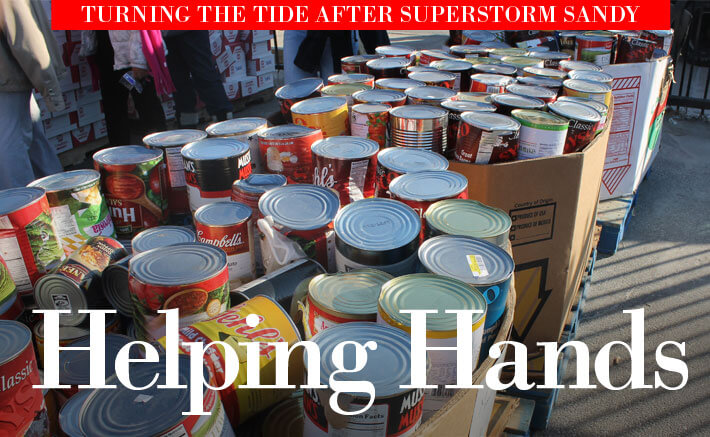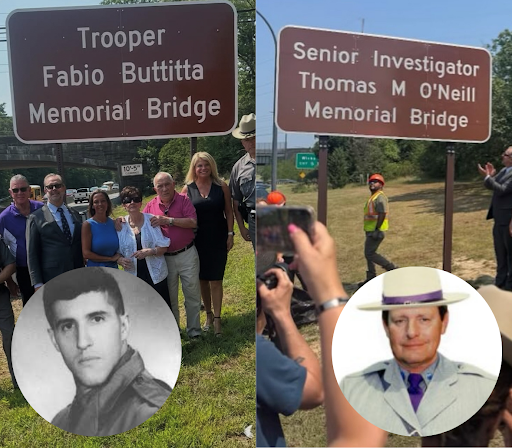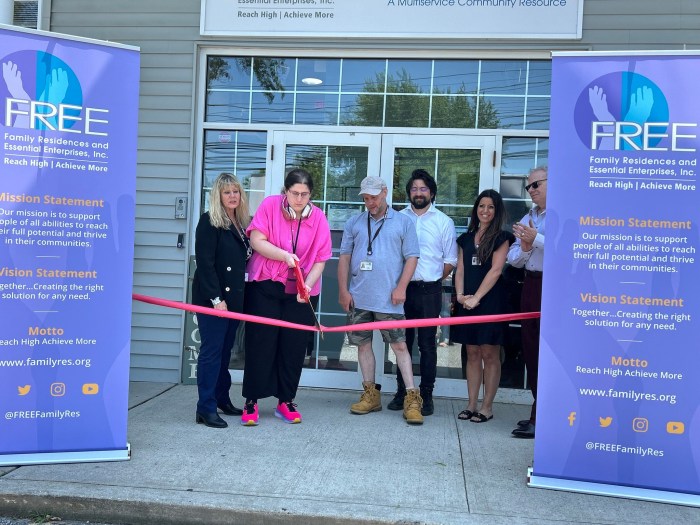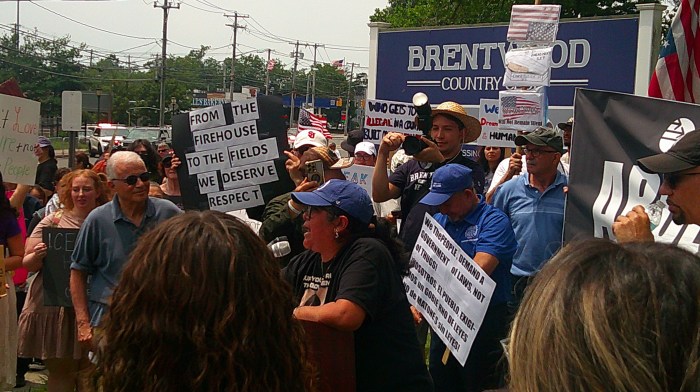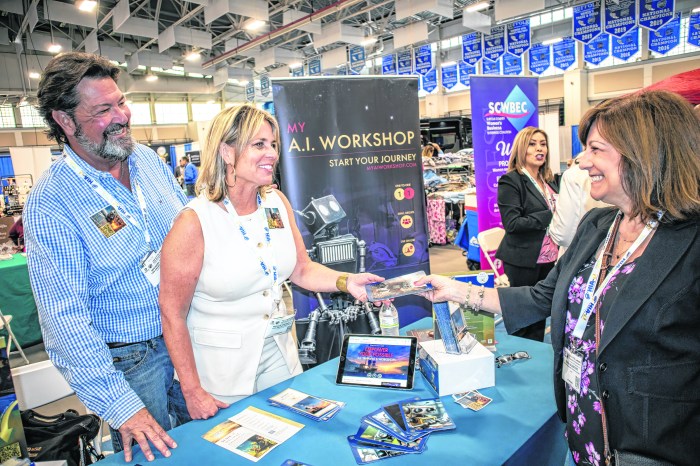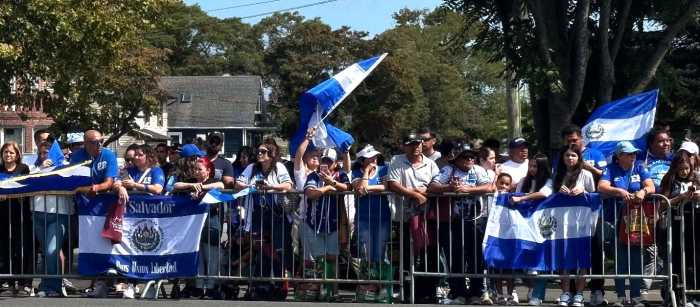Robert Suarez stood at the back of a Goya canned food truck in the parking lot of Bethpage Federal Credit Union Nov. 16 and unloaded crates of beans and water.
The father of three stacked them alongside piles of other donated food, supplies and non-perishables organized into bins to be reloaded onto a fleet of Island Harvest trucks and delivered to food pantries and soup kitchens across Nassau and Suffolk counties.
The haul ran the gamut—diapers, cereal, toiletries, paper towels, canned goods, turkeys—and grew throughout the day, fueled by a constant stream of residents driving up and dropping off the much-needed supplies.
Volunteers, such as Suarez, helped donors unpack the trunks of their vehicles, directed traffic, organized the contributions and sorted the flow.
Each year around Thanksgiving, food banks and pantries across the Island host turkey drives and free turkey dinners with all the trimmings to feed families and residents who are homeless or have no where else to go and nothing to eat. Post-Hurricane Sandy, these missions have taken on an added importance, as more Long Islanders join the ranks of the displaced, the homeless, and those in need.
Traditionally solely a turkey drive, Bethpage’s effort this year shifted to hurricane disaster relief, dubbed the Bethpage Turkey, Emergency Food & Relief Drive. In all, more than 2,500 turkeys were collected and more than 25,000 pounds of emergency relief items and non-perishables donated. This was just one of dozens of similar food-and-supply drives that have sprung up across the Island in the three weeks since Superstorm Sandy’s wrath.
“A young couple came here earlier with 50 turkeys—they emptied out an entire Pathmark,” Mineola-based Island Harvest President and CEO Randi Shubin Dresner said above the oldies playing from the table WHLI set up next to the donation drop-off. “Another couple from Locust Valley brought 20 turkeys. When you think about it, that’s a lot of money for people to spend.”
From hospitals, churches and synagogues to local fire departments, business owners and community leaders—some efforts are more organized than others; many are sparked merely from the generosity of a single Long Islander’s heart and snowball from there. Countless other random acts of kindness taking place throughout various communities between Long Islanders may never receive recognition.
Suarez, like so many others, could justifiably wait on the receiving end of his day’s work instead of unloading goods for others. He had just completed repairing the damages dealt to his Freeport home by Tropical Storm Irene in 2011 when a 5-foot-high wall of water, compliments of Hurricane Sandy, erased them all, decimating his entire first floor.
“I lost everything,” he told the Press, sharing photos of his capsized refrigerator lying on its side after Sandy’s storm surge hurled it across his kitchen. “I’m in the process of rebuilding again.”
Despite his loss, Suarez was there helping others while he and his family currently stay at a hotel, remaining upbeat considering the circumstances and downplaying his own plight several times in comparison with the tragedies still facing so many. The 44-year-old worked feverishly to make sure that others were able to celebrate Thanksgiving, yet he and his family still didn’t know what they were going to do for the holiday.
“I want to be thankful for what I do have, and give others positive reinforcement, that we can do this, we just have to take one day at a time,” he said.
Suarez’ selflessness is not the rarity in this post-Sandy Long Island, but the norm. Stories such as his are legion—a time of immense tragedy slowly unraveling as a period of tremendous strength and tenacity among residents.
And it’s this kind of selflessness that has defined so many local communities.

COMFORT FOOD
Three weeks of pent-up hurricane-sized emotions spilled out of Martha Aguinaga as she sat for an early Thanksgiving dinner Saturday in Long Beach with her family.
The 34-year-old mother of two choked up as she recalled the devastation suffered by inhabitants of the barrier island, her eyes filling with tears—then, like a single ray of sunlight peeking through the darkened clouds of a gloomy storm, an ear-to-ear smile.
“Just even driving here was just so wonderful because two weeks ago it was a nightmare that you could not wake up from,” she says, one child playing under the table and the other enjoying a hot meal along with hundreds of other Long Beach residents, volunteers and first responders.
A welcome reprieve from Sandy’s merciless destruction, the pre-Thanksgiving event was the brainchild of St. Francis Hospital President and CEO Alan Guerci, who decided to give out free meals by tri-state caterer Sterling Affair instead of hosting the hospital’s annual fundraising gala that night.
“When we saw the devastation, we said it’s just not right to have a party while people 10 miles away don’t have heat, electricity or drinkable water,” he told the Press in a hallway at Long Beach Regional Catholic School.
More than 200 turkeys, 400 pounds of stuffing and 500 pounds mashed potatoes were trucked in and handed out by volunteers, who greeted visitors with smiles as they sauntered in. Leftovers were donated to Island Harvest and other local charities.
For some, it was the first hot meal they had in weeks.
“After all the chaos we had, this is a very nice respite after cleaning up all the property and getting our house back in order,” said Steven, 59, who declined to give his last name.
The lifelong Long Beach resident has yet to toss away the wreckage from inside his home, instead, focusing on his elderly parents who lost their entire first floor and were stuck without heat and electricity.
“I think it’s beautiful,” said Julio Castillo, 37, a construction worker from Brentwood, of the free turkey and sides. “It’s a blessing to see the community come out, and for someone to dedicate their time out here, I think it’s really cool.”
Kerry Grober, 51, of Michigan, was one of those people. Armed with golf clubs for his annual pilgrimage to visit friends, he arrived one week before Sandy hit and has been hammering away with his friend Anthony, helping storm victims in Long Beach get back on their feet, ever since.
“The relationships that I’ve developed with the families that I helped will last a lifetime,” he said. “People need the help.”
St. Mark the Evangelist Church in North Bellmore, which offers outreach all-year round, morphed into a satellite donation center for the Episcopal Diocese of Long Island following Sandy, and on Monday was giving away Thanksgiving baskets filled with food to local families.
“It’s anonymously done,” said Ann McPartlin, head of the vestry and one of the organizers of the church’s charitable programs, of the donations, adding that some of the donors are storm victims themselves.
“A woman came with a lot of food to donate and we asked how she was doing,” says McPartlin. “She lost the first floor of her house, but she said she has a second floor and a lot of people don’t have anything so she wanted to help them.”
McPartlin says the church has not only received donations from locals, but from thousands of miles away.
Much-needed help is exactly what 10 U.S. Marines in camouflage fatigues and a half-dozen men and women dressed in purple Stop & Shop windbreakers provided as they stood huddled together in front of the loading docks of the Harry Chapin Food Bank in Hauppauge the morning of Nov. 15.
Wearing white Stop & Shop oven mitts, they formed a two-row human chain stretching from the back of a cargo truck, unpacking frozen turkeys and passing them from soldier to grocer into a large metal collection basket.
“We have 2,400 turkeys that will be divided evenly between Long Island Cares and Island Harvest,” said Arlene Putterman, manager of public and community relations for Stop & Shop. “That’s an increase of 500 turkeys from last year.”
“Overall, we distribute 5,000 to 7,000 turkeys and chickens,” added Robin Amato, director of development at Long Island Cares, explaining that post-Sandy, there’s an even greater need for donations of cleaning supplies and clothes.
For traditional food pantries and soup kitchens, such as Hauppauge’s Long Island Cares, the Lighthouse Mission in Bellport, Long Island Food Not Bombs and the Interfaith Nutrition Network (INN), the latest scramble to aid the destitute is nothing new.

BUSINESS AS USUAL
More than a dozen volunteers packed the lounge at The Inn in Hempstead Nov. 16, as Cynthia Sucich gave newcomers the rundown.
The group huddled close as Sucich, the group’s director of communications, fired away: Volunteers get in at 8:30 a.m. Monday through Friday, meals are served three hours later, guests are welcome to shower at The Inn, and always wear a hat, apron and gloves while handling food.
It was a message delivered by others like her hundreds of times throughout its 29-year history feeding the needy. Yet with Superstorm Sandy just two weeks old, the message was even more poignant.
“Everybody on one side of the counter can be on the other side,” she told them. “Everyone’s got a taste of what it’s like.”
Dozens of guests have already arrived for their afternoon meal at the soup kitchen. Bagels and salad are laid out. A cook prepares chicken soup in an oversized pot requiring an equally large spoon. Also on the lunch menu is chicken stuffed with Brie and cranberry—the cook offering a proud smile as he lifted the cover off the tray.
Sucich continued her speech in another room where bags of Thanksgiving goodies that have been prepared for their annual turkey drive were stored. More than 2,000 birds were expected to be handed out over the weekend.
Rookie volunteers teared up recalling one guest whose house recently went up in flames.
“Of course now you have someone who is now homeless,” she explained, “The storm is never-ending for many of our guests. For us, a lot of people will recover but our guests live in storms, their whole life is a storm.”
Sucich and the scores of veteran INN volunteers treated this day like any other.
“It’s a shelter every day for people,” she told the Press moments after her speech. “People ask about ‘Are we doing anything different for Sandy because of the hurricane?’ But what we do every day is exactly what people are in need of right now. We do this every day, we feed people every day, we house people every day, we clothe people every day, we give showers for people every day, so we’re not doing anything different than we normally do.
“But the need of course is greater because you have more and more people that never needed our services before and they’re coming and needing them now for the basic necessities.”
The Inn is also picking itself up from the devastation: Its usual donors are now the ones in need of help, and Sandy claimed two temporary housing units in Long Beach and Freeport that assist families looking to get out of the cycle of poverty. Two families living in Long Beach are now homeless again, said Sucich.
Additionally, the storm forced two fundraising events to be cancelled, leaving the group to ponder how they’ll recoup those funds.
“Right now we’re in a place where we’re scrambling to meet the need because of the lack of donations,” added Sucich.
Despite the challenges ahead, just like Robert Suarez, she remained upbeat, expressing appreciation for all the people who have called to volunteer their time for the holidays. Sucich only hopes that those same people will pick up the telephone again when the winter blows in and the destruction from the storm has faded from people’s minds.
“It’s always a season of giving for us, it never stops,” she said. “Why is it just around this time? People have to eat every day. People have to have clothing every day. This is not anything different.”





